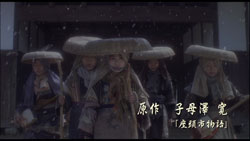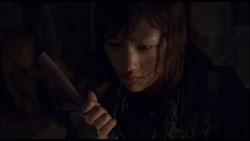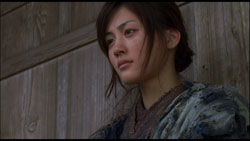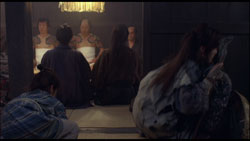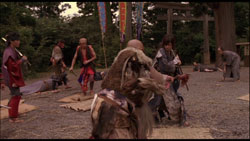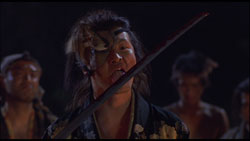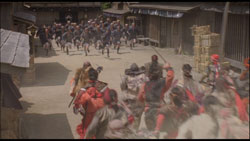 Logo handmade by Bannister
Column by Scott Green
Logo handmade by Bannister
Column by Scott Green
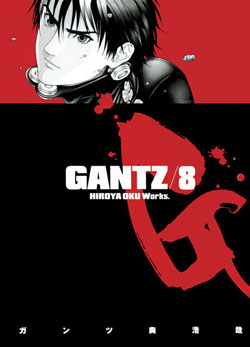
Manga Spotlight: Gantz Volume 8 by Hiroya Oku Released by Dark Horse Manga
Eight volumes in, I'm still not sure if I've misaligned my expectations for Gantz. I've been accused of refusing to read manga on its own terms. Here, I'm not sure if Oku is trying to comment on the excess of teen hero action stories, place his flag the summit of that heap of carnage, or skate from one serialized spectacle to the next. I'm more and more incline to think it’s the last of these. Regardless of what thought process brought him here, this volume is a noteworthy, transitional one. It's how they say, a game changer. The concept of Gantz is that a thinks-he's-smart teenage malcontent is carbon copied in the moment before a nasty death and reconstituted with other recently resurrected in a room with a black sphere. The mystery ball gives its subject resurrectees black, skin-tight suits, sci-fi weapons and the instructions to go hunt down one species of alien or another. Often, most of the sortie doesn't make it back, with our anti-hero joined by new substitutions in the subsequent outings. Oku has declared himself a Die Hard fan, and Gantz pulls of a similar trick to that movie's concept of a person with regular vulnerability thrust into abject peril. In action, these alien hunts play out like first person shooter games projected onto modern, urban Japan. This boasts the juxtaposition of weapons and creatures with ordinary people and ordinary places. It's shocking in its oddity, and it's shocking in its consequences. On a neighbor street, a non-super/action hero will get crushed under the foot of a giant, stone deity or eviscerated by the claws of an ogre. Gantz opens with the misanthropic judgments of its typical, unhappy teenager lead Kei Kurono. He thinks he's special, and, according to the recollections of his childhood friends, he actually did seem full of glorious promise as a kid. The tricky crux of Gantz is whether Kurono is in fact special. Half the time, the answer is emphatically and axiomatically "no!" Other times, in what could be considered direct contradiction, it is as if the manga backs his glorified self assessment and sense of privilege. This defining question, raised in the opening volume, is also underscored by the new developments of volume eight. Gantz opens with its lead guilted onto a subway track and graphically splattered by an express train. It's a nice way to knock someone down a few pegs, and in that red curtain pulling exercise, Gantz demonstrates that no one is special, least of all its lead. At times, the manga seems unflinching in that tenant. The unappealing, whether due to their ordinariness, unpreparedness or virtuelessness, are treated to painful, unenviable demises. The more recent turn is that the noble, skilled and compassionate have also been fed into the grinder. In Gantz' amoral slaughter, there is a sort of ethical comment on the genre. In this power fantasy gone awry, everyone is equal in their endangerment. The notion of chosen teen hero will be prove himself a member of the select when the crisis occurs is cast as false. With this sentiment, Gantz is sensational, but also seems a bit smart. Yet, recent volumes have shown that the game is winnable, or at least, can be engaged. Its threats can be challenged and bested. Some fall in the process. It is stacked against the players. But, victory is achievable, largely by accepting and working with the rules. If the players are given some outfit, no matter how pervy it might appear, they need to wear it to survive. If given some sort of blaster pistol, that toy looking object needs to be used to shoot the aliens in the head before their claws come out. Kurono proves to have the bravery and quick thinking to not only play and succeed at the challenge, but inspire devotion. If anyone's well suited to it, it might be him. The transitional volume eight of Gantz offers an ambiguous step in the dialog as to whether Kurano is in fact special. On one hand, Kurano is still subject to some of his earlier impotence. On the other, he receives the favor of plot deference to the lead. "Plot" might not be the right word in this case, and that in and of itself might be a clue as to whether or not Oku has a solid vision about that he's doing in this, the manga's most provocative, respect. Gantz is not lead by an exploration of the implication of it actions. Nor is it lead by a plotting of those actions. The driving force is ... driving force. For my part, I was grabbed by the cruel, provocative games that Gantz began playing with the conventions of a story in which a teenage male gets to prove himself in combat. In practice, momentum itself appears to be the ends of Oku's narrative. Something is always happening... not to be slowed down by a weepy, introspective lead... something twisted and transgressive... a violent death... introduction of a new threat...someone upsetting the apple cart... every chapter has to kick the manga solidly into the next.

Manhwa Spotlight: Shaman Warrior Volume 8 by Park Joong-Ki Released by Dark Horse Manhwa
North American followers of the field have asked why Korean manhwa is still trailing so far behind manga in capturing reader's interest. Without gaining much traction, it has remained more a sidebar than potential contender throughout the better part of the last decade. As intriguing as some manhwa titles are, it's my contention that manhwa has been a hard wagon to hitch to. While manga has had its share of cancellations and poor conclusions, manhwa, at least the sample that has been released in North America, has been stacked with audience alienating send offs. Between industry shake-ups in North America and South Korea and brain drain to video games, titles seem to either disappear or close down with rushed finales. This break down in followed titles has been dire enough to seem like a risk inherent in getting too involved in any manhwa series. Through its penultimate volume, the wheels are not coming off Shaman Warrior as spectacularly as other manhwa. I've read worse. It is however disappointing; neither as well considered in its plotting or illustrations as could be judiciously hoped for. There's quite a bit of noise from tertiary characters in this volume, and that's a problem. They're colorful additions to Shaman Warrior's landscape of swords and fists tribal warfare. Yet, they register as a distraction from the main show. Shaman Warrior is rapidly approaching its curtain call, and its hard to muster the faith that Park Joong-Ki has budgeted the time to develop a satisfying conclusion for the series' principals. In volume eight, Yaki, the ostensible protagonist, assassin-trained daughter of one of exterminated shamen, does get some on-page action time. As does Genji, the older, dangerous, ninja-ish woman veteran sidekick of Yaki's deceased father. However, their fights are gusts in a maelstrom. The confused plot convolution of rapidly changing battle lines could stand in for an organic, shifting conflict, but if that's the intension, it's a bit outside Park Joong-Ki's grasp as a writer. The basic draw and progression of the conflict needed to be sured up before all the extra twists were woven in. The greater disappointment is that Park Joong-Ki's illustration has lost some of its superlative precision. I'd previously help Shaman Warrior up as the gold standard for fight choreography in comics... regardless of origin. The size and position of combatants always seemed factored in on each panel and transition. If inspected and considered, there was always a logical way to justify how each fighter moved from one frame to the next. If you look at action comics, you'll find that this occurs from less often than stand alone frames of action or loosely choreographed exchanges of blows. With Park Joong-Ki's attention to detail, the comprehensiblity and excitement of the violent amalgam of wushu and mixed martial arts has been secured. Volume 8 drops a surprising amount of that thought-through quality. This is not to the extent that you can take one glance at Shaman Warrior and tell that Park Joong-Ki is no longer putting out the same degree of effort. The fights are still as furious and exotic as ever. The volume is peppered with exchanges of swords, or swords and whips and poison, or swords and sickles and weird, chicken footed grappling lines. Park Joong-Ki still exhibits a great visual imagination, such as a guy fighting with a thin pipe in this mouth, only to have it fill with blood as he's stabbed. Shaman Warrior still delivers on as much sharp, dismembering action as you can possibly hope for. As someone who was previously astonished by how well the fights had been illustrated, volume eight was astonishingly peppered with panels and transitions that didn't click. A perspective shot would capture a view over the shoulder of a man with an outstretch arms and pointed figure, and the anatomical dimensions will look entirely off. A reverse angle panel transition will break the coherent flow of the action. Always, there was a logical story for how position in one panel set up the next. Now, a blade will mysterious drift from one hand to the next between frames. There's cause to believe that Shaman Warrior is going be another entry in the litany of manhwa that skulks out the door rather than makes a dramatic exhibit. This isn't to say that Shaman Warrior should be discounted. Diminished Shaman Warrior is still better than the average action comic. Park Joong-Ki isn't the artist or writer that Hiraoki Samura is, but his style does approach Blade of the Immortal’s course violence and charismatic vulgarity. Better plot and illustration up to the standards of earlier volumes could be hoped for, but the issue is more a matter of a disappointment than real ineptness.
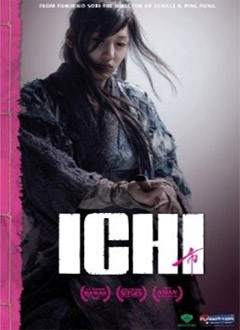
Live Action Spotlight: Ichi Released by FUNimation
In this colorful update of a chambara/clash of swords classic, then 22 year old Haruka Ayase draws a blade previously wielded by large, grizzled guys - some of whom held the role for decade or two. "Haruka Ayase" is a name selected by a fan poll. Her recent work includes "Happy Flight" and "Oppai Volleyball" (oppai being a juvenile word for breasts), and she is a singer/idol/model/whatever. Yet, though the closest thing to a work that North American fans would know is Violet in the Japanese dub of the Incredibles, it does seem like she's specialized in acting. She isn't bad at it either, convincingly carrying her new generation pulp hero in Ichi. Though she's drably dressed, Ayase's Ichi fits into an often colorful revision of the Tokugawa shogunate, helmed by Fumihiko Sori, one of the maestros of modern, CG augmented film; who made a name with effects animation on Titanic, produced the first CG Appleseed, directed the CG animated Vexille, and, as far as what's really relevant to Ichi goes, previously applied his live action vision to an adaptation of Taiyo Matsumoto's (TekkenKinkreet) sports story Ping Pong. As demonstrated in Ping Pong, Sori takes a now familiar took kit... dilating time, extensively flexible focus, and video game-like floating camera, and adeptly applies it towards crafting an experience that reflects the perception and thinking of his subjects or the tone of the material.Bright, CG sprays of blood trail from a chambara work, which, by the standards of most of the dueling centric genre, is punctuated by an abundance of action. The proceedings are stylized within an inch of absurdity. An angsty young woman looks to rectify a traumatic upbringing. In that journey, she finds herself meeting, sometimes crossing swords with, other troubled wanderers and broadly sketch villains - played by the likes of Shido Nakamura, Ping Pong's "Dragon" Ryûichi And Ryuuku Of Death Note, Yôsuke Kubozuka, Ping Pong's Peco and Riki Takeuchi, actor in a host of yakuza movies and the title role of Ginji the Slasher. If Ichi isn't chambara for the anime crowd, then it's chambara for the broader category of fans of modern, Japanese pop culture. However, at least from an American perspective, that apparent intension doesn't match my observations of the movie's reception. I'm no connoisseur of chambara, but I have seen a fair amount from a fair number of styles, directors and decades. I know Ichi's source material and how it fits into the larger framework of the genre. From that vantage, I appreciated the movie as an interesting variant. I wouldn't want all new chambara to turn Ichi-like, but as a spiced up branch, it was fun. From what I've seen, that isn't an unusual reaction form chambara fans willing to loosen up on some purist tendencies. In contrast, the North American anime fan reactions have tended to be cold to negative. They understood the movie's plot and context, but without a connection to the genre conventions which it refracted, it didn't involve them. I think I've previously written about my antipathy for top ten lists. I do however have a geeky love for top 10 lists of movie samurai because of the inevitable twist the conversation will take. Shouldn't the blind swordsman Zatoichi be on the list? Introduced in Kan Shimozawa's novels , the character as played by Shintaro Katsu starred in a 26 movie franchise from 1962 to 1989. There, he crossed blades with the Shaw Brothers' One Armed Swordsman and Toshiro Mifune's yojimbo of the Akira Kurasawa movies. In the 70's, the Shintaro Katsu played character lead four TV series. And, in 2003, Takeshi Kitano directed starred in a reimagining of the character, with bleached hair and a particular attention to rhythm. The reason why Zatoichi shouldn't be in any top 10 samurai movie lists is right in the title... Zato-no-Ichi or Ichi the Zato. The title character, Ichi, is far from a samurai. He's a zato, the lowest rank of the Todoza, an Edo era guild for the blind disbanded during the Meiji restoration; a traveling masseur on the bottom rung of society. Jidaigeki period serials have more than their share of characters who are almost ritually underestimated in every episode. A classic example is Mito Komon, a TV show approaching its 40th season, featuring a supposed retired merchant who travels with his two body guards. He seems like a wealthy old gentleman of no great importance or ability. But, in every episode he discovers a problem, and, with his surprisingly able retinue, is able to best any corrupt or trouble making opposition. Finally, the merchant displays his crest, revealing that he is really former vice-shogun and retired daimyo Tokugawa Mitsukuni. Specializing in iaido quick draw technique, zato Ichi is literally and figuratively underhanded. Travelling as an itinerant masseur, Ichi is sometimes an assassin. More often, he's involved with yakuza activity. Frequently, he's a gambler, using his acute hearing to listen for how dice fall and whether they might be loaded. Like Kurasawa's Yojimbo and his descendants, Ichi would wander into a town divided by a war between gangs or subjected to injustice. And, in that Yojimbo mode, he'd insinuate himself in the conflict, not always for what appeared to be humanitarian ends. And yet, the character ultimately settles the injustice. Yojimbo aka Kuwabatake Sanjuro aka Tsubaki Sanjuro aka Sassa Daisakka is a bit of a morally gray character. However, Ichi goes even further into ambiguous territory. The viewer is on his side, with his rough charisma, his general propensity to use his abilities as the hyper-capable underdog to help other underdogs, and for being a consistent, lethal force. Yet, while the character does good, the viewer is left wondering how deep the deception and the darkness goes. Far from the formal directness of a samurai or surgical ambushes of assassins, Ichi is a bit of a twit in engaging in psychological warfare; playing up blindness to aggravate or intimidate foes; holding out a candle at the end of his sword or doing a bit of a stumble feint. And, beyond his combat MO, his exact yakuza heft is a bit unknown. Is he dissembling by hinting that there's more there than just the amazing skill, or is there something directing his wanderings? "Ichi's" Ichi is the daughter of Ichi. She is/was a member of the Gozeza, the female equivalent of the Todoza, but was expelled for contact with a man after being assaulted. Rather than employing the masseur cover occupation for her wandering/gambling, she's a shamisen playing music performer. And, beyond her father's skill with dice, she also picked up his deadly speed and accuracy with a cane-sword. The man who she's searching for might not be the Ichi of Zatoichi and might not be her biological father, but for practical purposes, that bit of ambiguity doesn't really matter. Maybe, if there are later Goze Ichi movies, that might be leveraged. What is important is that Ichi has not entirely reconciled herself as an individual, distinct from her troubled past and the role a her blind swordsman father in that history. Early scenes of Ichi show her wandering an icy winter road with a group of goze begging, then dirty and alone, trying to eek together a few necessities. She bemoans her detachment from human contact, then draws her blade and fends off a would-be attacker. "I don't know what I cut, because I can't see." To the point of this specific movie, she finds a partner of sorts; albeit a self appointed one. When she becomes the would-be victim of a gang, he steps in, and proves to be inept in providing the unneeded protection. After Ichi's kills are attributed to this white knight, the guy is hired by a relatively honest yakuza gang as muscle in their turf war with a less traditional, more brutal group. Chambara, especially samurai based chambara, is full of ritual. Even in gritty works, there's a formalism to the way in which weapons are drawn and battles are engaged. An essential part of the draw here is Ichi's contrast to that ideal. The character is barely even interested in the deception and the reveal. The father got into the game from time to time. The daughter does it as a necessity, and even then snarls. She can't even manage to let the loser who thinks he saved her delude himself for a moment. Couple this the ferocious gaze Ayase adopts when engaged in battle, the no-nonsense character curves herself a distinctive position in the genre. On the other hand, Ichi is not exactly an ideologically current movie. Its views on yakuza and heroic death are rather romanticized. For a movie with a female lead, there's a surprising bit of men punching comrades in the face to psyche themselves up for rushing into death. Nor is this a film that is particularly progressive about gender. Ichi is defined by her relationship with men, whether its her father or the film's adversary. Beyond her agenda to find her father, her propensity tends towards being reactive. Post introductory first act, when the movie starts moving, she's surprisingly marginalized. In the gang conflict that structures the movie, she's hardly a commanding catalyst, residing on the edge for most of the action. It could be said that this is a rookie's tale and that might be a valid defense to the character's inability to direct the movie's story. It could be argued that an empowered woman wandering Edo Japan is a bit unrealistic and inaccurate; not that a blind young woman walking through the era's roads, looking beautiful is terribly verite either. For a character with little patience in a movie trying to be current, it would have been nice to have a woman lead with more agency. Hiroshi Kuze handles choreography, and he's a big name in the field, having served in the capacity in late Kurasawa films, including the epic Ran, earlier Ichi incarnations and Twilight Samurai. The staging of the films fights is evocative. Ichi and the majority of her allies/adversaries aren't samurai. They don't duel in the manner of that class in the Edo era. These are toughs, mercenaries and yakuza. As such, they brawl. Gangs wolf pack surround victims. Armed contingents literally clash, as they draw swords and barrel down an alley towards each other. The approach is exciting. It seems like you in store for something impressively violent. Once the weapons start moving, my enthusiasm towards the action became more measured. Some of the details are too stylized. When the swordspeople dodge, the swing misses by a foot and not an inch. The more dissatisfying issue is more macro. There's a hierarchy of martial ability evident from the plot and dressings. Ichi's talented. The chief antagonist is talented. Some of his more colorful, more attention grabbing lieutenants are likewise able. Yet, if you look at how these characters move and handle themselves, that relative skill is not evident. The players are better actors than fighters, and even then, the exaggeration on their faces used to convey in combat expressions is extreme. Other than his rank plumage, what allows guy X to put Ichi on her heels while guy Y is dispatched with a flick of the sword cane? It's not demonstrated by what is on screen. As such, victory or defeat turns into a function of the plot's progression. With an attractive, modern actress wandering Edo era Japan, suspicion of disbelief is a requirement for enjoying Ichi... though no more than the majority of most anime. Beyond that, what helps is a connection to samurai and other chambara flicks. Ichi appears to be trying to reach out to an audience with modern tastes, but a bit of familiarity helps to appreciate the twist. It's still pantomime, and better in its introduction than follow through, but there's still something like about this colorful ornament on the genre.

